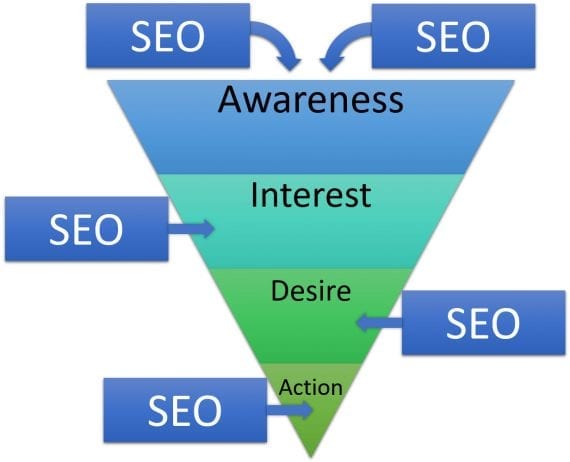Ecommerce marketers spend a lot of time thinking about the sales funnel. Search engine optimization plays a major role in filling that funnel at the various stages.

Search engine optimization greatly impacts the traditional AIDA sales funnel — awareness, interest, desire, action.
In aggregate, we can look at certain types of keyword searches that target content at different stages of the funnel. Some keyword types are better at awareness building for most searchers, while other keywords signal an intent to purchase.
Depending on the shopper, it’s possible that a single search for a specific phrase could trigger every stage of the funnel at once, from awareness to action. This is especially true of searches for a specific product, where the consumer has already done her homework and knows exactly what she wants to purchase, but not where. In that case, the steps of the funnel apply not to the product but to the ecommerce site.
For SEO, the key is where in that sales process you intercept a shopper as she’s searching.
Awareness
Awareness is the most obvious stage of the funnel for SEO to play a role in. Searchers want something. They ask Google or another search engine to generate relevant sites. The search results are sometimes shoppers’ first exposure to your site. They may have never heard of your company before. That initial and extremely brief introduction is your first shot at seeding awareness.
It’s important to meet searchers where they are in the journey. At the awareness stage, they want information. The keywords that shoppers use to search are your entry into their awareness.
At this phase, we need to target informational, educational, or general product category keywords to make that critical first introduction to searchers.
For example, a shopper may want “gifts for men who have everything,” “how to build a retaining wall,” or “men’s shoes.” That’s a wide array of keywords. But they all are informational, educational, or related to the general product category. For any of these keywords, an ecommerce site could meet a prospect for the first time, generating awareness of its brand or product.
Awareness-building keywords can spawn other awareness keywords as the searcher swirls around the mouth of the funnel before dropping down to the next stage. For example, “gifts for men who have everything” could easily trigger a categorical product search, such as “tech gifts.”
With product category searches, your home page or major category pages will earn the bulk of the traffic. For the informational and educational searches, specific content pages will be required. Don’t expect to attract those searches with the same pages that sell products. The types of content required for each are different.
Some SEO professionals would disagree with my categorization of longer phrases as awareness generators. It’s a common practice to use the number of words in a search phrase as a measure of its location in the funnel, with the shorter phrases at the top of the funnel and the longer ones driving action at the bottom.
I disagree with this characterization, however, because long-tail informational and educational keyword phrases imply no transactional intent. Someone who wants to find “gifts for men who have everything” — and there are an astounding 3.5 million of those searches in December in the U.S. according to the Google Keyword Planner — could be looking for a gift guide to buy something as-yet unknown, not a specific product to purchase. The phrase implies intent to purchase a gift at some time, but not at this precise moment.
Interest and Desire
However, awareness is not the only role of SEO. You can also intercept searchers and draw them into your site in the middle of the funnel. In the AIDA model — awareness, interest, desire, action — search marketers often clump interest and desire together because it’s difficult to distinguish between the two in terms of the keywords used.
These keywords tend to be slightly longer and more specific than awareness-driving keywords. But that’s not always the case. Searchers might add a modifier, such as a size, color, or brand.
For example, an awareness level search for “men’s shoes” could trigger interest-desire searches for “Steve Madden men’s shoes.” That phrase indicates that the shopper is narrowing in on a purchase, but isn’t quite ready to purchase a specific pair of Steve Madden shoes. Searches that contain the word “reviews” also imply interest or desire.
Action
Keywords with specific product names, numbers, or attributes signal desire to purchase. These searchers know what they want, just not where they’re going to buy it. They may be narrowing in on the best site to buy from, or they may have seen the product in a brick-and-mortar store.
For example, action-oriented keywords may include product types with multiple parameters like “Steve Madden men’s boots zipper” or “Steve Madden men’s dress boots.”
Action-oriented keywords are attractive because they are the most likely to produce a sale. But they’re also difficult to optimize manually because there are so many of them. Who would have thought to optimize for “Steve Madden men’s boots zipper”? Searches like these can be targeted at scale in a couple of ways: through a long-tail filtered search strategy or through highly optimized product pages that contain many product details.
Determining which keywords sit at which levels of the funnel is subjective and relative. It’s subjective in that the same 100 keywords could apply to different categories. And it’s relative in that an awareness-driver on one site could be an action-driver for another, depending on the business model.
But make a start. Don’t worry about how someone else would do it. Take your keyword research and outline the keyword areas that make sense for your business. Align those keywords with the three areas of the funnel that SEO can drive traffic to. And then make sure you have content that fills the needs of each of those areas.




